General Remarks
This is the evaluation for the courses Digital Engineering [w3] and Electrical Engineering [w3] at the faculty of Electrical Engineering at the HTWG Konstanz. Courses are offered at two fixed dates per week, lecture and lab, 90 minutes each. Attendance is possible from a university classroom or from home office. A compulsory attendance is not possible by legal regulations except for explicit on-site laboratories if scheduled as such in the study plan. The faculty Electrical Engineering and Information Technology does not apply admission tests for examinations in general so that all students of a semester and branch of study are eligible examination candidates by definition. Students' attendance discipline or work performance is usually not measured by the faculty. The examination office of the university builds the examination lists for all registered students of a branch of study. Examiners are asked by the faculty to examine unlisted students. The examining board of the faculty will decide on the correctness of the attendance later.
All of my courses make use of the inverted classroom teaching method so that students' preparation becomes mandatory to attend the weekly appointments. The examinations are carried out in digital form so that no prints and no travel is required. Attendance is possible from the university campus or from home offices. A monitoring of students during the examination is performed by camera and/or microphone in alignment with the legal regulations. Students are allowed to use the entire course material during the examinations. The online-examinations are as such barrier-free.
The quality management is based on an attendance documentation. Attendance rates are correlated to examination results to investigate input-output performance. The numbers presented below might appear inconsistent because of "unknown" or de-registered students. "Unknown" students are individuals that seemingly exist only on paper (indicated "NV" in the diagrams below). While listed on the official examinations lists they never appear in lectures, exercises, labs or examinations nor do they register on course pages or respond to contacting. De-registered students are individuals that officially cancel their examination attendance between the finalization of the examination lists and the date of examination.
There is in general some uncertainty in the presence statistics because some students might don't want their presence to be tracked and therefore attend in groups from the university campus.
Course Evaluation Summer Term 2025
1. Digital Engineering [w3] - Summary
The course content is structured in modules delivered by scripts, exercises with sample solutions, lecture videos (MP4) and simulation models. Meeting notes are distributed as PDF files to support individual time management and learning speeds.
The minimum rate of points to pass the examination is 42%, i.e. 25 out of 60 points. Grades higher than 4 do not pass the examination.
| Distribution Of Points |
 |
| Digital Engineering - Overview Of Grades (1 - Best Grade, 4 - Minimimum Grade to Pass) |
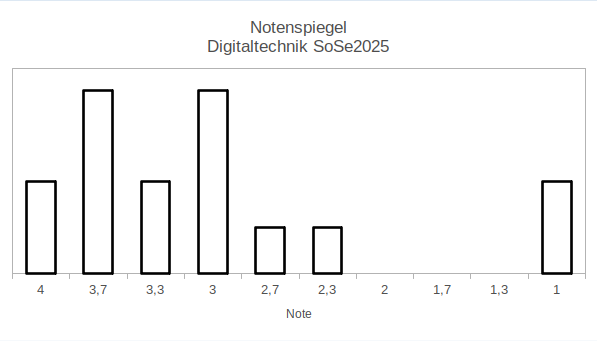 |
| Digital Engineering - Simulated Pass Rate |
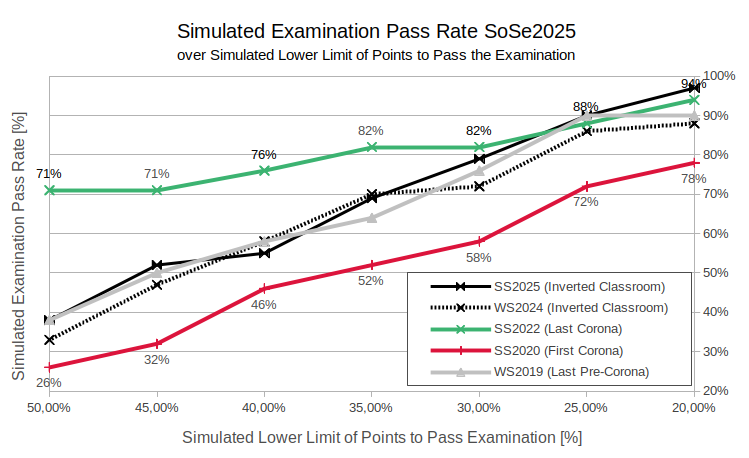 |
The simulated examination pass rate is based on a simulated variation of the minimum rate to pass. The curves give a footprint of the collective knowledge of a course. This makes the collective students knowledge comparable over semesters. Example (green solid line): if 50% (30 out of 60 points) would have been the minimum rate of points to pass, 71% of students would have passed in the summer term 2022 (corona semester).
| Digital Engineering |
Enrolled |
Examined |
Attn Rate |
Passed |
Pass Rate |
| 1st attempt |
32 |
24 |
75% |
15 |
63% |
| 2nd attempt |
5 |
4 |
80% |
0 |
0% |
| 3rd attempt |
1 |
1 |
100% |
1 |
100% |
| Total |
38 |
29 |
76% |
16 |
55% |
1.1.1 Technical Branch - Bachelor Electrical Engineering (EIB) - Regular Examination
| Technical Branch - Digital Engineering (EIB) - Regular Examination |
 |
| Exam EIB (1st Semester) |
Enrolled |
Examined |
Attn Rate |
Passed |
Pass Rate |
| 1st attempt |
- |
- |
-% |
- |
-% |
| 2nd attempt |
- |
- |
-% |
- |
-% |
| 3rd attempt |
- |
- |
-% |
- |
-% |
| Total |
- |
- |
-% |
- |
-% |
1.1.2 Technical Branch - Bachelor Electrical Engineering (EIB) - Assessment Examination
Students in the first semester are eligible candidates for an assessment examination per examination regulations.
| Exam EIB (1st Semester) |
Enrolled |
Examined |
Attn Rate |
Passed |
Pass Rate |
| 1st attempt |
- |
- |
-% |
- |
-% |
| 2nd attempt |
- |
- |
-% |
- |
-% |
| 3rd attempt |
- |
- |
-% |
- |
-% |
| Total |
- |
- |
-% |
- |
-% |
1.2 Economic Branch - Bachelor Industrial International (IWI) - Regular Examination
| Digital Engineering (IWI) |
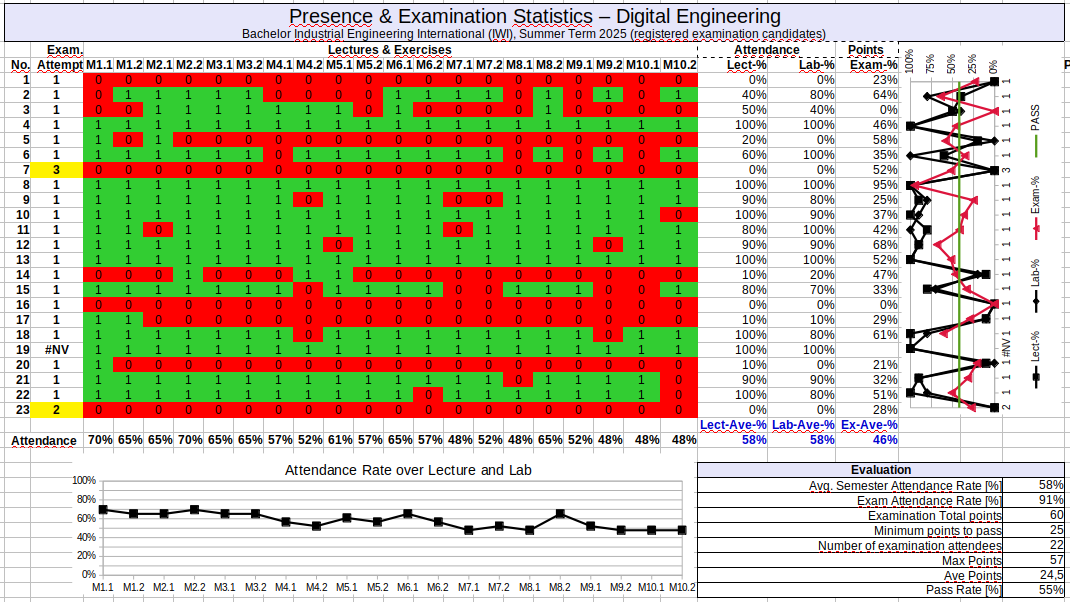 |
| Exam IWI (2nd Semester) |
Enrolled |
Examined |
Attn Rate |
Passed |
Pass Rate |
| 1st attempt |
20 |
18 |
90% |
10 |
56% |
| 2nd attempt |
1 |
1 |
100% |
0 |
0% |
| 3rd attempt |
1 |
1 |
100% |
1 |
100% |
| Total |
22 |
20 |
91% |
11 |
55% |
1.3 Economic Branch - Bachelor Industrial Engineering (EIW) - Regular Examination
| Digital Engineering (EIW) |
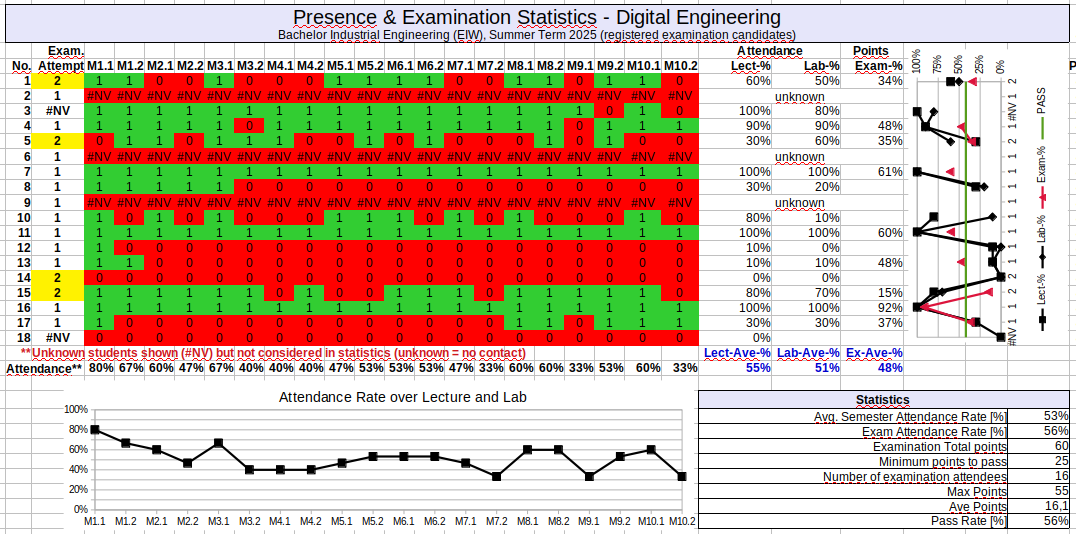 |
| Presence map with attendance and examination statistics. |
| Exam EIW (2nd Semester) |
Enrolled |
Examined |
Attn Rate |
Passed |
Pass Rate |
| 1st attempt |
12 |
6 |
50% |
5 |
83% |
| 2nd attempt |
4 |
3 |
75% |
0 |
0% |
| 3rd attempt |
0 |
0 |
-% |
- |
-% |
| Total |
16 |
9 |
56% |
5 |
56% |
1.4 Technical Branch - Bachelor Intelligent Mobility Systems (IMS) - Regular Examination
The course Digital Engineering is in general not offered in the winter term for this branch of study. All candidates prepared themselves in self-study with the available online material, i.e. lecture videos, PDF exercise notes, exercises and former examinations including sample solutions.
| Digital Engineering (IMS) |
 |
| Exam IMS (2nd Semester) |
Enrolled |
Examined |
Attn Rate |
Passed |
Pass Rate |
| 1st attempt |
- |
|
-% |
- |
-% |
| 2nd attempt |
- |
- |
-% |
- |
-% |
| 3rd attempt |
- |
- |
-% |
- |
-% |
| Total |
- |
- |
-% |
- |
-% |
2. Electrical Engineering [w3]
The course content is structured in modules, delivered by weekly lectures (90 min) and labs (90 min). Students get a working set of digital documents including literature, script, exercises with sample solutions, former examinations with sample solutions, lecture videos (MP4), a weekly digital summary (PDF) of lecture and lab appointments, special work packages (ZIP archives) on specific topics including LTSpice simulations and a detailed summaries of the theory including examples. Special revision dates are offered two times per semester for repeaters, i.e. students that failed the examination in a previous attempt. Repeaters normally do not follow the regular course schedules due to time conflicts. The revision dates offer a condensed rework of theory and practice to quickly refresh contents. The offer is regularly used by all students of a course to repeat.
The minimum rate of points to pass the examination is 44%, i.e. 20 out of 45 points. This is the lowest level to pass since 2015.
2.1. Electrical Engineering - Summary
| Electrical Engineering (Total) |
Enrolled |
Examined |
Attn Rate |
Passed |
Pass Rate |
| 1st attempt |
36 |
18b) |
50% |
7 |
39% |
| 2nd attempt |
27 |
16 |
59% |
4 |
25% |
| 3rd attempt (or highera)) |
11 |
10 |
91% |
3 |
30% |
| Total |
74 |
44 |
59% |
14 |
32% |
a) examination attempts for attestations without gradings are UNLIMITED per examination regulations
b) one attendee did not drop an exam sheet
| Pass Rate Simulation |
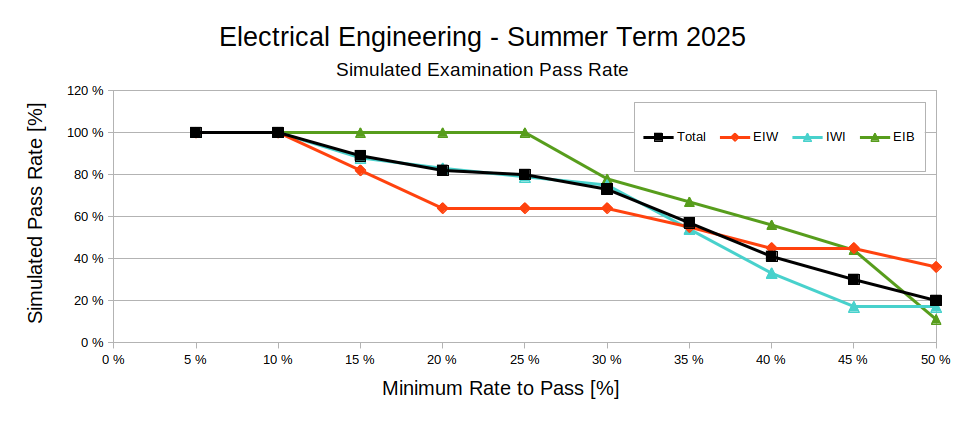 |
2.2 Technical Branch - Electrical Engineering (EIB) - Ungraded Certificate
| Bachelor Electrical Engineering (EIB) |
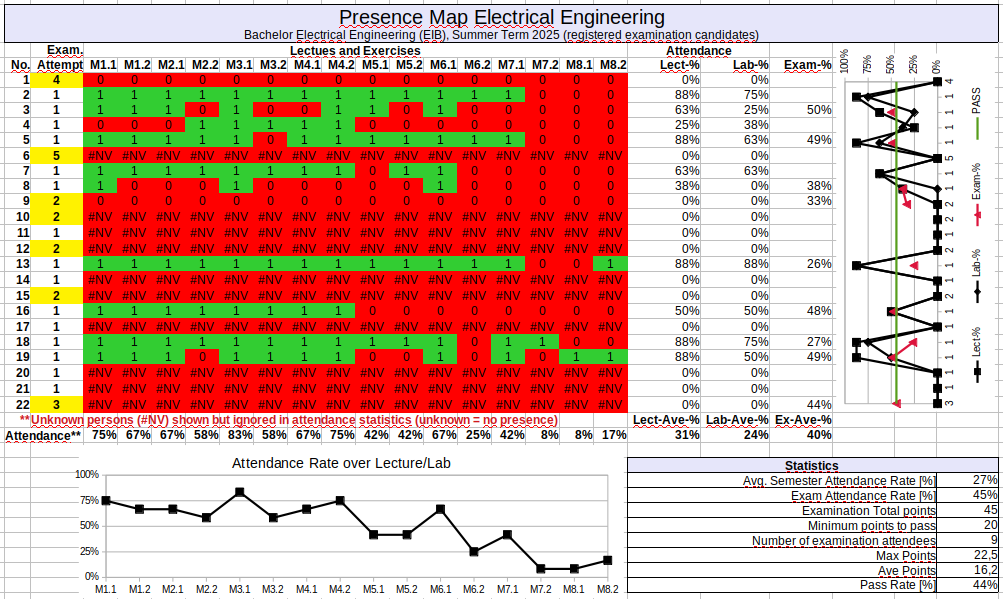 |
| Presence map with attendance and examination statistics. |
| Exam EIB (1st Semester) |
Enrolled |
Examined |
Attn Rate |
Passed |
Pass Rate |
| 1st attempt |
15 |
7 |
47% |
4 |
57% |
| 2nd attempt |
4 |
1 |
25% |
0 |
0% |
| 3rd attempt (or higher*) |
1 |
1 |
100% |
0 |
0% |
| Total |
20 |
9b) |
45% |
4 |
44% |
*examination attempts for attestations without gradings (called 'Schein') are UNLIMITED as per examination regulations
b) one attendee did not drop an exam sheet
2.3 Economic Branch - Bachelor Industrial Engineering (EIW) - Ungraded Certificate
| Bachelor Industrial Engineering (EIW) |
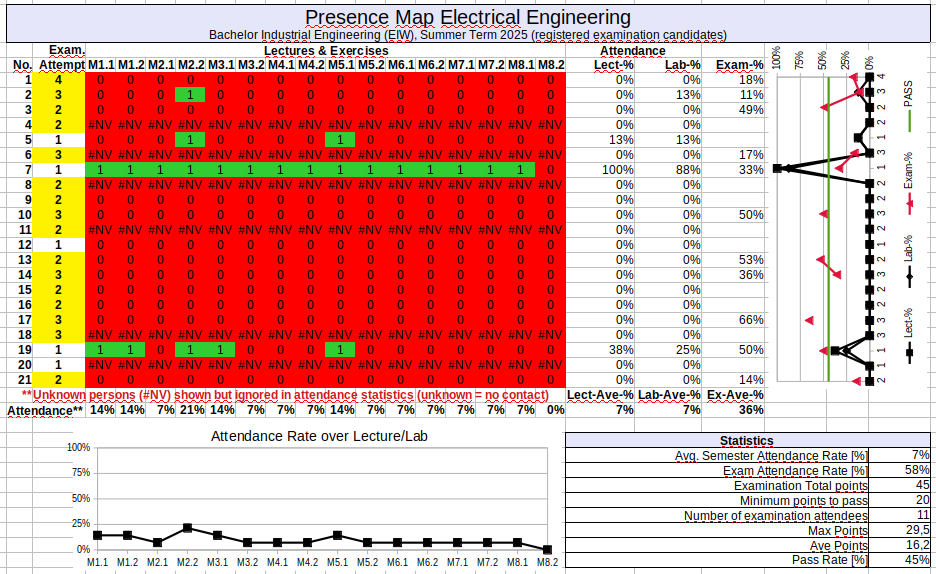 |
| Presence map with attendance and examination statistics. |
| Electrical Engineering (EIW) |
Enrolled |
Examined |
Attn Rate |
Passed |
Pass Rate |
| 1st attempt |
4 |
2 |
50% |
1 |
50% |
| 2nd attempt |
9 |
3 |
33% |
2 |
67% |
| 3rd attempt (or higher*) |
6 |
6 |
100% |
2 |
33% |
| Total |
19 |
11 |
58% |
5 |
45% |
*examination attempts for attestations without gradings (called 'Schein') are UNLIMITED as per examination regulations
2.4 Economic Branch - Bachelor Industrial Engineering International (IWI) - Ungraded Certificate
| Bachelor Industrial Engineering International (IWI) |
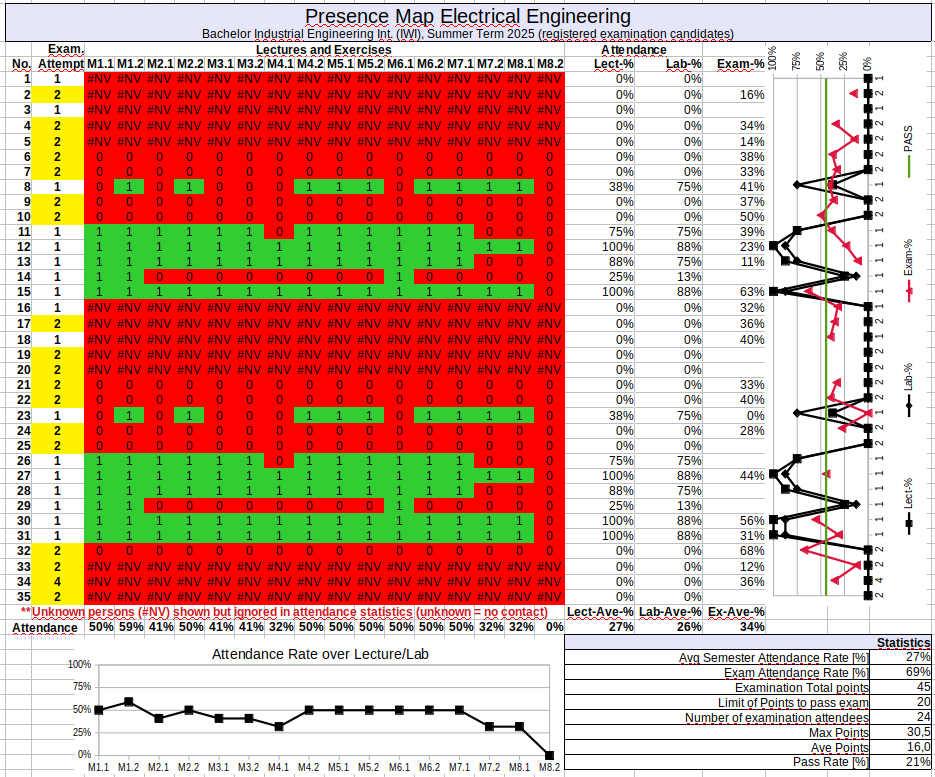 |
| Presence map with attendance and examination statistics. |
| Exam IWI (1st Semester) |
Enrolled |
Examined |
Attn Rate |
Passed |
Pass Rate |
| 1st attempt |
17 |
9 |
53% |
2 |
22% |
| 2nd attempt |
14 |
12 |
86% |
2 |
17% |
| 3rd attempt (or higher*) |
4 |
3 |
75% |
1 |
33% |
| Total |
35 |
24 |
69% |
5 |
21% |
*examination attempts for attestations without grading (called 'Schein') are UNLIMITED as per examination regulations
 SS'25 - Print Savings due to Online-Examinations - 1320 Sheets.
SS'25 - Print Savings due to Online-Examinations - 1320 Sheets.
Calculation: 10 sheets per examination (double-sided color prints for German and English versions) in average times registered attendees plus 10 prints for unregistered attendees. Unregistered attendees are allowed to attend the examination as per instruction of the examining board of the faculty. It will be decided later by the examination offices of the faculty, if the attendance was permitted.
Note: Students are registered for examinations by the University automatically and without self-action. The low attendance rates at examinations are the reason for lots of wasted prints. The University sticks to this practice despite several indications with the reasoning that students forget regularly to enroll for examinations. I therefore decided after the Corona pandemic to offer Online-Courses and Online-Examinations to eliminate this waste.
The waste savings due to prints for registered but non-attending students was 730 sheets of paper (i.e. 55%). This amount would have been printed and dumped. Students normally (some rare exceptions do exist) do not collect these prints for training purpose as far as I can confirm.











 SS'25 - Print Savings due to Online-Examinations - 1320 Sheets.
SS'25 - Print Savings due to Online-Examinations - 1320 Sheets.